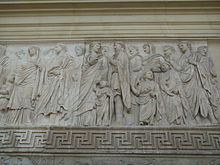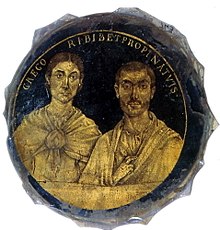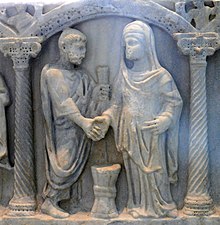Concubinage is an interpersonal and sexual relationship between two people in which the couple does not want to, or cannot, enter into a full marriage. Concubinage and marriage are often regarded as similar, but mutually exclusive.
The pater familias, also written as paterfamilias, was the head of a Roman family. The pater familias was the oldest living male in a household, and could legally exercise autocratic authority over his extended family. The term is Latin for "father of the family" or the "owner of the family estate". The form is archaic in Latin, preserving the old genitive ending in -ās, whereas in classical Latin the normal first declension genitive singular ending was -ae. The pater familias always had to be a Roman citizen.
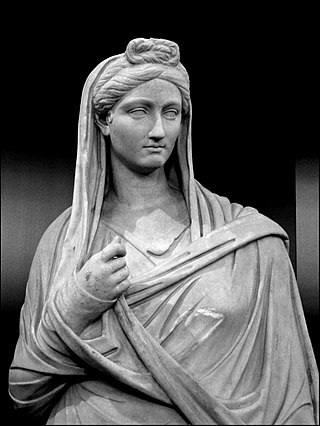
Freeborn women in ancient Rome were citizens (cives), but could not vote or hold political office. Because of their limited public role, women are named less frequently than men by Roman historians. But while Roman women held no direct political power, those from wealthy or powerful families could and did exert influence through private negotiations. Exceptional women who left an undeniable mark on history include Lucretia and Claudia Quinta, whose stories took on mythic significance; fierce Republican-era women such as Cornelia, mother of the Gracchi, and Fulvia, who commanded an army and issued coins bearing her image; women of the Julio-Claudian dynasty, most prominently Livia and Agrippina the Younger, who contributed to the formation of Imperial mores; and the empress Helena, a driving force in promoting Christianity.

Adoption in ancient Rome was primarily a legal procedure for transferring paternal power (potestas) to ensure succession in the male line within Roman patriarchal society. The Latin word adoptio refers broadly to "adoption", which was of two kinds: the transferral of potestas over a free person from one head of household to another; and adrogatio, when the adoptee had been acting sui iuris as a legal adult but assumed the status of unemancipated son for purposes of inheritance. Adoptio was a longstanding part of Roman family law pertaining to paternal responsibilities such as perpetuating the value of the family estate and ancestral rites (sacra), which were concerns of the property-owning classes and cultural elite. During the Imperial era, adoption became a way to ensure imperial succession.

Citizenship in ancient Rome was a privileged political and legal status afforded to free individuals with respect to laws, property, and governance. Citizenship in ancient Rome was complex and based upon many different laws, traditions, and cultural practices. There existed several different types of citizenship, determined by one's gender, class, and political affiliations, and the exact duties or expectations of a citizen varied throughout the history of the Roman Empire.

The legal rights of women refers to the social and human rights of women. One of the first women's rights declarations was the Declaration of Sentiments. The dependent position of women in early law is proved by the evidence of most ancient systems.
In ancient Rome, confarreatio was a traditional patrician form of marriage. The ceremony involved the bride and bridegroom sharing a cake of emmer, in Latin far or panis farreus, hence the rite's name. The Flamen Dialis and pontifex maximus presided over the wedding, and ten witnesses had to be present. The woman passed directly from the hand (manus) of her father or head of household to that of her new husband.
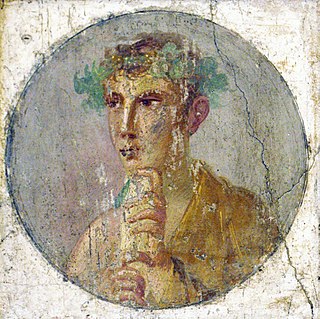
In Roman law, status describes a person's legal status. The individual could be a Roman citizen, unlike foreigners; or he could be free, unlike slaves; or he could have a certain position in a Roman family either as head of the family, or as a lower member.

Marriage in ancient Rome was a fundamental institution of society and was used by Romans primarily as a tool for interfamilial alliances. Roman marriage was a monogamous institution: Roman citizens could have only one spouse at a time but were allowed to divorce and remarry. This form of monogamy in Greco-Roman civilization may have arisen from the relative egalitarianism of democratic and republican city-states. Early Christianity embraced this ideal of monogamous marriage, and perpetuated it as an essential element in many later Western cultures.

Social class in ancient Rome was hierarchical, with multiple and overlapping social hierarchies. An individual's relative position in one might be higher or lower than in another, which complicated the social composition of Rome.
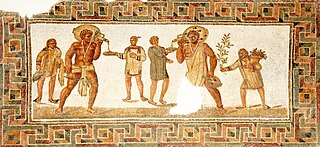
Slavery in ancient Rome played an important role in society and the economy. Unskilled or low-skill slaves labored in the fields, mines, and mills with few opportunities for advancement and little chance of freedom. Skilled and educated slaves—including artisans, chefs, domestic staff and personal attendants, entertainers, business managers, accountants and bankers, educators at all levels, secretaries and librarians, civil servants, and physicians—occupied a more privileged tier of servitude and could hope to obtain freedom through one of several well-defined paths with protections under the law. The possibility of manumission and subsequent citizenship was a distinguishing feature of Rome's system of slavery, resulting in a significant and influential number of freedpersons in Roman society.

Manus was an Ancient Roman type of marriage, of which there were two forms: cum manu and sine manu. In a cum manu marriage, the wife was placed under the legal control of the husband. In a sine manu marriage, the wife remained under the legal control of her father.

Education in ancient Rome progressed from an informal, familial system of education in the early Republic to a tuition-based system during the late Republic and the Empire. The Roman education system was based on the Greek system – and many of the private tutors in the Roman system were enslaved Greeks or freedmen. The educational methodology and curriculum used in Rome was copied in its provinces and provided a basis for education systems throughout later Western civilization. Organized education remained relatively rare, and there are few primary sources or accounts of the Roman educational process until the 2nd century AD. Due to the extensive power wielded by the pater familias over Roman families, the level and quality of education provided to Roman children varied drastically from family to family; nevertheless, Roman popular morality came eventually to expect fathers to have their children educated to some extent, and a complete advanced education was expected of any Roman who wished to enter politics.

Wife selling is the practice of a husband selling his wife and may include the sale of a female by a party outside a marriage. Wife selling has had numerous purposes throughout the practice's history; and the term "wife sale" is not defined in all sources relating to the topic.

The New Testament Household Codes, also known as New Testament Domestic Codes, consist of instructions in New Testament writings associated with the apostles Paul and Peter to pairs of Christian people within the structure of a typical Roman household. The main foci of the Household Codes are upon husband/wife, parent (father)/child, and master/slave relationships. Some argue that The Codes were developed to urge the new first century Christians to comply with the non-negotiable requirements of Roman Patria Potestas law, and to meet the needs for order within the fledgling churches. The two main texts that address these relationships and duties are Ephesians 5:22–6:9 and Colossians 3:18–4:1. An underlying Household Code is also reflected in 1 Timothy 2:1ff., 8ff.; 3:1ff., 8ff.; 5:17ff.; 6:1f.; Titus 2:1–10 and 1 Peter 2:13–3:7. Historically, proof texts from the New Testament Household Codes—from the first century to the present day—have been used to define a married Christian woman's role in relation to her husband, and to disqualify women from primary ministry positions in Christian churches.
In civil law jurisdictions, marital power was a doctrine in terms of which a wife was legally an incapax under the usufructory tutorship of her husband. The marital power included the power of the husband to administer both his wife's separate property and their community property. A wife was not able to leave a will, enter into a contract, or sue or be sued, in her own name or without the permission of her husband. It is very similar to the doctrine of coverture in the English common law, as well as to the Head and Master law property laws.
Childbirth in ancient Rome was dangerous for both the mother and the child. Mothers usually would rely on religious superstition to avoid death. Certain customs such as lying in bed after childbirth and using plants and herbs as relief were also practiced. Midwives assisted the mothers in birth. Once children were born they wouldn’t be given a name until 8 or 9 days after their birth. The number depended on if they were male or female. Once the days had passed, the child would be given a name and a bulla during a ceremony. When a child reached the age of 1, they would gain legal privileges which could lead to citizenship. Children 7 and under were considered infants, and were under the care of women. From a age 8 until they reached adulthood children were expected to help with housework. The age of adulthood was 12 for girls, or 14 for boys. Children would often have a variety of toys to play with. If a child died they could be buried or cremated. Some would be commemorated in Roman religious tradition.
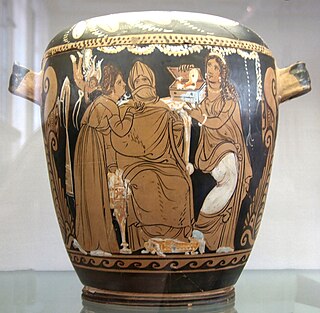
Marriage in ancient Greece had less of a basis in personal relationships and more in social responsibility, however it is important to note; the available historical records on the subject focus exclusively on Athens or Sparta and primarily on the aristocratic class. According to these records, the goal and focus of all marriages was intended to be reproduction, making marriage an issue of public interest. Marriages were usually arranged by the parents; on occasion professional matchmakers were used. Each city was politically independent and each had its own laws concerning marriage. For the marriage to be legal, the woman's father or guardian gave permission to a suitable man who could afford to marry. Daughters were usually married to uncles or cousins. Wintertime marriages were popular due to the significance of that time to Hera, the goddess of marriage. The couple participated in a ceremony which included rituals such as veil removal, but it was the couple living together that made the marriage legal. Marriage was understood to be the official transition from childhood into adulthood for women.

In ancient Rome, contubernium was a quasi-marital relationship between two slaves or between a slave (servus) and a free citizen who was usually a former slave or the child of a former slave. A slave involved in such a relationship was called contubernalis, the basic and general meaning of which was "companion".

Concubinatus was a monogamous union, intended to be of some duration but not necessarily permanent, that was socially and to some extent legally recognized as an alternative to marriage in the Roman Empire. Concubinage became a legal concern in response to Augustan moral legislation that criminalized adultery and imposed penalties on some consensual sexual behaviors outside marriage.
